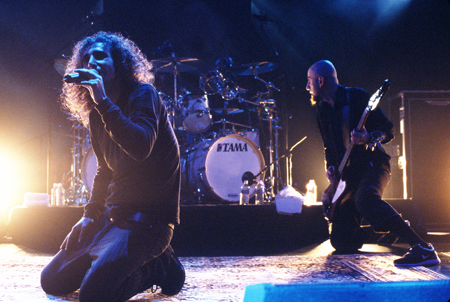|
Reviews of Recent Independent, Foreign, & Documentary Films in Theaters and DVD/Home Video
Directed by: Carla Garapedian. Produced by: Nick de Grunwald, Tim Swain, Carla Garapedian & Peter McAlevey. Director of Photography: Charles Rose. Edited by: Bill Yahraus. Music: System of A Down & Jeff Atmajian. Released by: MG2 Productions/Maya Releasing. Language: English & Armenian with English subtitles. Country of Origin: UK. 91 min. Rating R.
In the arenas of white American rock ‘n’ roll where ethnic identity is rarely acknowledged,
System of a Down has consistently heralded their Armenian heritage over the decade they have been performing and recording top-selling albums.
(Two members were born in Lebanon, one in Armenia and the fourth in Hollywood.) Part and parcel with their pride, they have worked to raise
consciousness about the 1915 Turkish genocide of Armenians through their music, concerts and public activities. Their early song “P.L.U.C.K”
(“Politically Lying Unholy Cowardly Killers”) demonstrated how their passion about the cause even fueled their name: “The plan was mastered and
called Genocide (Never want to see you around)/Took all the children and then we died/The few that remained were never found…/All in a system of
Down.” The 11 songs by the band featured here in concert performances recall the style of metal band Metallica, but are very personally and
politically charged.
Screamers is more about wider politics than just one band, as in Shut Up & Sing. The interviews with fans on ticket lines and
backstage with the band members go on a bit too long, like countless other rock docs, but some of the kids wear anti-genocide T-shirts and
express admiration for the band’s politics as they rock out. A legacy of being instilled by great-grandparents to never forget is dramatically
demonstrated through lead singer Serj Tankian, who looks a lot like the late Frank Zappa, as he visits his 96-year-old grandfather Stepan Haytayan,
one of the oldest living witnesses of the horrors of the government-instigated mass killings. The film includes extensive accounts from Tankian’s
earlier home videos as well as testimony of two other aged survivors, interspersed with family and archival photos. As the band lobbies its fans
from the stage, they also appear at a rally in former House Speaker Dennis Hastert’s home district in Illinois for support of a Congressional
resolution to charge Turkey with genocide, and the camera catches Tankian formally, and very politely, buttonholing Hastert in the U.S. Capitol rotunda.
Also briefly interviewed about Turks’ attitudes is dissident Turkish-Armenian journalist Hrant Dink, whose recent murder is generating the first mass protests in his homeland for reconciliation. While Turkish government propaganda is held up to ridicule, the film is careful not to tar Turks in general. Various charges are bruited about how the military industrial complex has allied with Turkey to influence Congress, but the film also neglects to mention the leverage Europe now has over Turkey due to its request for membership into the EU.
But those lacking some familiarity with the history of the Turks’ attacks on Armenians as the Ottoman Empire collapsed during World War I and the refusal ever since of Turkish governments to admit or even discuss responsibility will be a bit hard-pressed to follow the facts that are thrown around in no particular order by various academics, educators, human rights activists, writers and other experts. Henry Morgenthau III speaks early in the film, but it isn’t explained until the last half hour, and then cursorily, that his grandfather was the U.S. Ambassador to Turkey who provided a detailed report to his neutral government on the systematic nature of the onslaught. (An ongoing problem for a film about memory is that the talking heads, including the band members, are mostly identified only the first time they appear.)
The film culminates in a Daily Show-like parade of former and current presidents and State Department functionaries dancing around “the G word” from the 1980’s on as it fits their perceptions of U.S. strategic interests against Communists or terrorists around the world. Screamers is most challenging when it raises the issue of how empty the rhetoric of “never again” is in a world of instant information if governments don’t actually do anything to back that up.
Unfortunately, the film emphasizes the shock value of a constant stream of many, many graphic photographs and a lot of footage of
piles of bodies, skeletons and hordes of helpless children, whether in Armenia, Auschwitz, Bosnia, Cambodia, Kurdistan, Rwanda, or Darfur.
Thoughtful points are made in a hurry at the end, such as the issue of the fog of civil war covering up acts of genocide, which gets more confused
as none of the experts actually calls out which group was seeking to exterminate what other group in the massacres carried out by Pol Pot’s Khmer
Rouge, in the Balkans, or now in Darfur.
Concluding with System of a Down’s plaintive “Holy Mountains” played over scenes of the Armenian homeland, Screamers is less an educational
documentary than a look at an unusual way to get young people, who wouldn’t watch PBS or the History Channel
but who might go to a Live Aid concert, talking and exploring.
Nora Lee Mandel
|

